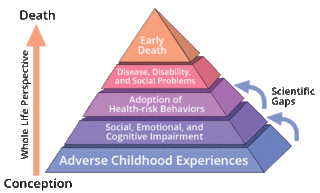Trauma
Diagnosing and Treating PTSD and Complex PTSD
An Interview with trauma therapist Brad Kammer.
Posted September 28, 2022 Reviewed by Lybi Ma

Part I of II
I can’t remember the first time I heard the word trauma. Vietnam, the wars in Afghanistan and Iraq? When did trauma enter popular parlance? Was it after 9/11? I recently learned that there are now 6,000 podcasts with trauma in the title. Are we in the midst of a trauma epidemic? Or does this reflect our growing understanding?
Trauma refers to a wound to the psyche or the body or both. We now know that not only experiencing trauma oneself but witnessing trauma or being told about a traumatic event can be traumatizing.

To help us understand one of the emerging approaches to diagnosing and treating trauma, Brad Kammer has some insights. He is currently on the faculty of the NARM Training Institute—the NeuroAffective Relational Model is a treatment model developed by Dr. Laurence Heller, Brad’s long-time mentor, to address the impact of adverse childhood experiences and complex trauma. “In NARM, we recognize that in most cases we cannot change the traumas we experience. But, we can change the ways we have adapted in order to survive these traumas,” he explains.
Brad brings to his work a holistic approach that includes body-oriented therapies as well as a deep knowledge of attachment theory and survival styles. He and Heller recently co-authored The Practical Guide for Healing Developmental Trauma: Using the NeuroAffective Relational Model to Address Adverse Childhood Experiences and Resolve Complex Trauma. In a world reeling from destabilization, violence, hatred, and suffering, Brad Kammer and his colleagues at NARM present an opportunity for healing and hope.
(Note: This will be a two-part interview.)
When many of us hear the word trauma, we think of soldiers, people caught in war zones or natural disasters, but you make a clear and valuable distinction between what you call shock trauma and relational or developmental trauma. Can you explain the difference?
It is difficult to differentiate because as humans we experience both shock and relational traumas, often at the same time. For example, a parent who physically hurts a child will create a shock trauma reaction in response to the physical violence in the context of the relational failure of the parent not protecting or keeping their child safe from harm.
This is an extremely simplistic way to differentiate it, but in my teaching, I often use this as a short-hand to distinguish between PTSD and C-PTSD: PTSD (post-traumatic stress disorder) is about the psychobiological process of fear, and C-PTSD (complex post-traumatic stress disorder) is about the psychobiological process of shame. While there is certainly much overlap, research suggests there are different neural circuits responsible for fear than for shame.
The example I often use is you’re walking in the woods and a bear jumps out at you. In that very moment, you’re not worrying about your relationship with the bear, you just want to survive. Your brain will bypass the emotional, relational and cognitive centers and go straight to activating the hyperarousal centers of the brain to optimize your chances for physiological survival. Mortal threats activate the fight-flight response. This is experienced through fear.
Now imagine that the threat isn’t a bear jumping out of the words; it’s your parents, and each day of your life you feel that your sense of security in the world, and within yourself, is not welcomed or supported, but may be dismissed, undermined, or attacked. This puts you into a bind; as young children, we cannot run or fight against the people we are 100 percent dependent on for our survival. While these threats may not be immediately life-threatening like the bear, we still have to find ways to survive the ongoing, persistent failures in our development.
Humans are designed to be connected to themselves and others. When connection to self and others becomes fraught with pain and danger, we use various strategies to disconnect from ourselves and the pain that we experience internally. One such process involves the way we relate to ourselves through shame and self-rejection. We internalize the failures of our early environment and personalize them as our inherent failures. These shame-based identifications form the foundation of our personality development.

Many people don’t even consider this trauma. Many people, including clients and health professionals, wonder if we are broadening the term trauma too much. “This is just life,” they say. “This is just how childhood is.” But minimizing and dismissing the effects of these failures is itself a sign of unresolved trauma.
My mentor used to say, “In a world of bent-over people, the one standing upright looks strange.” I push back on the notion that we use trauma too broadly. I argue that we don’t have a broad enough understanding of the impact of unresolved complex trauma.
What are some other ways in which PTSD is different from Complex PTSD?
As the trauma field continues to evolve, we have begun to more clearly differentiate between post-traumatic stress disorder (PTSD) and complex post-traumatic stress disorder (C-PTSD). PTSD, which is sometimes called “shock trauma,” is generally caused by one-time events like accidents, assaults, and natural disasters, and leads to hyper- and hypo-arousal in the nervous system that creates symptoms like intrusive images, flashbacks, hypervigilance, avoidance, and dissociation.
C-PTSD is generally caused by relational and social failures, and leads to disorganization and insecurity in one’s sense of self, as defined by the three symptom categories that include affect dysregulation, negative self-concept, and interpersonal disturbances. Developmental trauma, a subset of C-PTSD, is generally caused by adverse childhood experiences that impact a child’s development. NARM was created specifically to address C-PTSD, focusing on attachment and developmental trauma, but also working with larger social failures such as cultural and intergenerational trauma.
The trauma-informed field has been rapidly growing over the past 40 years since the first introduction of PTSD into the DSM in 1980. While this field has made tremendous strides, our understanding of complex trauma has lagged behind. Trauma pioneer Dr. Judith Herman suggested that PTSD doesn’t go far enough, and presented “a new diagnosis” in her 1992 book Trauma and Recovery, which she called C-PTSD. And yet here we are in 2022 and we still don’t have an official complex (C-PTSD) or developmental trauma disorder (DTD) diagnosis in the United States. This means that many people are being misdiagnosed, or at the very least, are being treated for secondary issues. What if many of the symptoms and disorders we see in our clients are driven by unresolved early trauma? This changes the way we look at diagnostic categories and even challenges how we currently view psychopathology.
As we describe in our work, maybe it’s not about “what’s wrong with you?” but about “how have you adapted to what happened to you?” For many of us in the trauma field, we see many “symptoms” and “disorders” as understandable reactions and adaptations to abnormal conditions and environments. This is particularly true for children and how they have learned to adapt to persistent failures in their early lives. These are not one-time traumas that can easily be resolved. This is the territory of complex trauma, and it truly is very complex to understand. It is also challenging to treat. This is why we need comprehensive therapeutic models that understand how to identify, navigate, and address this complex territory.




